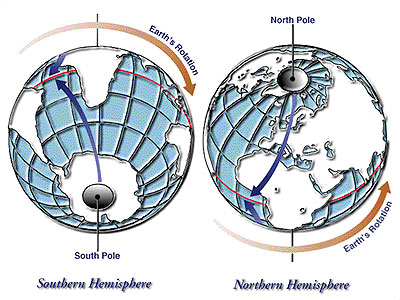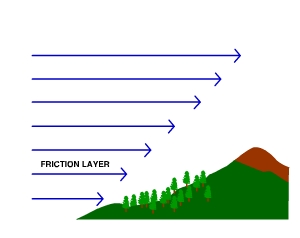Coriolis ForceThe Coriolis force is the effect of earth rotation on the direction of the wind. The Coriolis force arises for two reasons, first our directional system of latitude and longitude has been fixed to a rotating earth. Thus, our frame of reference for monitoring the direction of a free-moving object above the Earth is constantly changing. The second reason is the amount of turning about a vertical axis varies from a maximum at the poles and minimum at the equator. Demonstrate this by standing a pencil on end at the north pole and turn the globe. The pencil completes one full rotation. But standing the pencil on end at the equator and rotating the earth yields no rotation about a vertical axis. Figure 6.9 shows the deflection that a missile experiences when shot from the North Pole towards the Equator. Because the Earth, and the target, has rotated underneath the free-moving missile, it appears that the missile has veered off course (changed direction). Such is the case for winds blowing above the surface. The deflection works the same way for an east-west wind, the path will curve to the right as it moves across the surface. Go to Coriolis Force animation Figure 6.9 The influence of
the Coriolis force on wind. Though the air is deflected to the right of its path in the Northern hemisphere, in the Southern Hemisphere wind is deflected to the left of its path. Why the difference? It all has to do with perspective. Pick up a globe and spin it in a west to east direction. Now look down on it from above the North Pole. It appears to by spinning in counterclockwise direction. Now keep it spinning from west to east, lift the globe over your head and look at it from above the South Pole. It appears to be going in a clockwise direction. (Kind of weird, huh?) FrictionGenerally speaking wind speed increases with height above the surface as the frictional force of surface diminishes with height. The friction imposed on air mechanically slows the wind and diverts its direction. The friction layer is the layer of air that is influenced by friction caused by the surface. The friction layer varies in height across the Earth, but for the most part lies within about a kilometer of the surface.
Investigate how geoscientist measure and analyze wind by "Digging Deeper: Measuring, Visualizing, and Analyzing Wind Direction and Speed" or skip and continue reading. |

